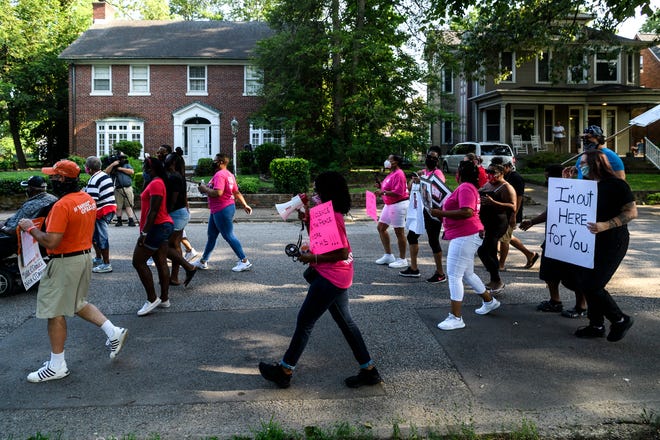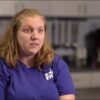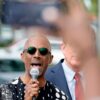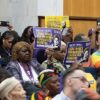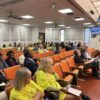By Brooke Endale and Christina Elias, Evansville Courier & Press
EVANSVILLE, Ind. — It’s been nine years since Bridgett Tate’s son, Derrick Brian Jackson, was murdered six blocks from their home. She still calls the Evansville Police Department every week seeking answers in the unsolved homicide.
“If I didn’t stay on it, he would just be forgotten,” Tate said. “And that’s not – that was my only child. I’m only making it because I want to see my son get justice before I die.”
Her son, who went by Brian, was shot on Chandler Avenue, between Garvin and Governor streets. It’s hard to remain in Evansville, she said, especially in the same neighborhood where Brian died. But fighting to get justice for her son is the only thing that gets her up in the morning now, Tate said.
She’s involved with Mothers Against Senseless Killing and has spoken publicly many times about Brian’s death.
“You don’t get over it. You do not get over losing a child,” Tate said. “Every time you hear of somebody else’s child being murdered like this, it brings it all back up again.”
A continuing crisis
Gun violence in Evansville has been increasing over the years, as has the number of lives lost.
This year, 62 people were victims of shootings in the city as of Dec. 10, according to Evansville Police. As of Dec. 23, police had responded to 802 shots fired calls and 14 homicides. And 422 guns have been seized.
Compare that to 2019. That year there were 56 shooting victims, 10 homicides, 686 shots fired calls and 531 guns seized.
Gun violence in 2020 is the second-highest it’s been for the last five years, according to EPD data. The only year with higher rates was 2017, and 2020 doesn’t lag far behind.
In 2017, Evansville recorded 64 shooting victims, 19 homicides and 820 shots fired calls, and 480 firearms were seized.
“Over the past, I’d say, four or five years, it’s started hitting here in Evansville pretty hard,” EPD Chief Billy Bolin said. “A lot of these people that are shooting at each other are teenagers.”
Not only are perpetrators and victims trending younger, but the violence is impacting communities of color disproportionately. Black men make up the largest demographic for both victims and suspects.
From 2016 to 2020, 149 Black men and 35 Black women were victims of shootings, compared to 40 white men and 19 white women. One shooting victim was a Hispanic man.
Over the last five years, 27 Black men were victims of homicides, six Black women, 19 white men, seven white women and one Hispanic man.
When victims or witnesses provide a suspect description, those also overwhelmingly trend toward Black men. On average, from 2016 to 2020, 56% of shooting suspects were described as Black males.
Feelings of hopelessness
Community members say the gun violence in Evansville is turning their lives upside down.
A woman living on Evansville’s South Side with her husband, who asked for her name not to be used for fear of harassment, said she proudly bought a home 20 years ago that she loved. Now she feels trapped there.
She hears gunshots almost every other night in her neighborhood. On two occasions, she woke up to find stray bullets lodged in her home. Another time, in her car. Someone was shot and killed in front of her neighbor’s house. She’s lost loved ones to shootings and fears for her younger relatives.
No one should have to live like this, she said.
The woman said she feels hopeless, saying all she can do is pray for God’s protection over her nieces and nephews.
“I’m fearful for them as young men trying to grow up in Evansville,” she said. “Knowing the ones you love so dearly could just walk out the front door or walk into the gas station to get a soda and be killed. It’s crazy.”
The people carrying out the shootings aren’t showing any signs of stopping but instead seem more brazen.
“They’re not even doing it in the cover of darkness anymore,” she said. “In broad daylight, people are getting shot and killed and hurt. And why?”
Looking for answers in the crisis
That question is critical to addressing this crisis, said Evansville City Council President Alex Burton, who’s been outspoken about combating gun violence in Evansville.
He said when there are kids as young as 14 or 15 years old getting their hands on guns and carrying out shootings, there’s a problem.
Burton believes Indiana’s gun laws, the ease in which juveniles can get their hands on guns and the lack of programming and resources for at-risk youth in Evansville are causing this crisis.
“It’s all related,” Burton said. “And we need grassroots efforts. It’s going to take some real work, and it’s going to have to be intentional.”
He believes the community needs to be strategic in how resources are allocated. To reach the most at-risk, often young Black men, there needs to be programming and mentorship to engage them.
When kids lack a support system and activities or interests to occupy their time, it’s easy for dangerous things to grab their attention instead, Burton said.
He said the city and community needs to invest in programs and people who can effectively reach at-risk youth.
Working to focus on individuals, not groups
In Evansville, law enforcement have shifted focus to monitoring individuals rather than gangs, which tend to be disorganized and constantly evolving. Phernetton said it’s more effective to focus on individuals. He said there are about 13 identifiable gangs in the city, but only ever two to three groups actively feuding with each other.
Phernetton said the VIPER Unit’s approach is to deter repeat offenders with a zero-tolerance policy.
“We try to relentlessly put pressure on those that are creating the most problems in our city,” he said. “You know, even if they’re not currently wanted for anything, we try to stay visible and in their face. My response to them when they call, or the mothers will call to complain about being harassed is, ‘That’s right. As long as you’re committing crimes in our city, we’re going to harass you. If you don’t want to be bothered by the police, don’t commit crimes, or you can feel free to move.’”
